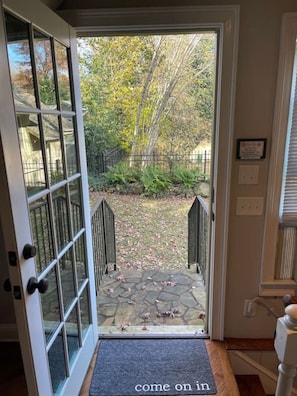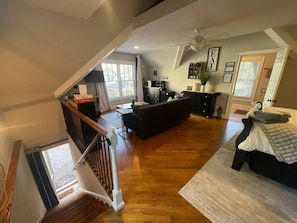Tiny House Living in heart of ATL +secret backyard
Overview
Rooms and Beds
| Room | Count | Capacity | Details |
|---|---|---|---|
| bedroom | 1 | sleeps 2 |
|
| bathroom | 1 |
|
Description
Welcome to your new favorite getaway tucked in one of ATL’s most beautiful & centrally located neighborhoods. The carriage house is located in the back of main unit & has its own private entrance & fenced backyard. Our little carriage house punches far above its weight class when it comes to amenities and value. Even though its just one room, every inch has been designed to make sure our guests have everything they would ever need to relax, work, cook, and sleep in style and comfort.Experience luxury living in this fully equipped carriage house featuring air conditioning, a full bathroom, spacious living room, and a convenient kitchenette. Relax and unwind in the comfort of a queen-size bed while enjoying your favorite shows on the 32 inch TV. Indulge in the ultimate level of comfort and style during your stayGuests will be able to access the entire carriage house located behind the main home. The carriage house has its own private fenced in backyard. Guests are also welcome to use the outdoor fireplace and outdoor dining area but please note these spaces are shared with the main unit.We live down the street and can be contacted through the Airbnb app or our cell phone.ith its beautiful linear park and parkways designed at the turn of the 20th century by Frederick Law Olmsted, the Druid Hills Historic District richly deserves its designation on the National Register of Historic Places. Today, it resides remarkably near the center of Atlanta’s sprawling metropolitan area.Some find it hard to believe that this magnificent urban neighborhood was conceived and executed as one of Atlanta’s first suburbs. Yet it continues to evoke the past with its winding roads, eclectic architecture, and green canopy. The U.S. Department of the Interior once declared Druid Hills to be “significant as the finest example of late 19th and early 20th century comprehensive planning and development in the Atlanta area, and one of the finest period suburbs in the Southeast.In the early 1890s, Atlanta entrepreneur Joel Hurt, who had imaginatively developed transportation, utilities, and real estate in the city, assembled a large tract of land for residential use. He hired Frederick Law Olmsted, America’s premier landscape architect, to plan his “ideal residential suburb.”By the time Olmsted began to design Druid Hills in 1893, he had already completed many prominent projects including Central Park in New York City, the grounds of the United States Capitol, the Biltmore Estate in North Carolina, Prospect Park in Brooklyn, and the Stanford University campus. He also designed numerous park and parkway systems Boston, Chicago, and other cities.Early in his career Olmsted planned (with his colleague Calvin Vaux) the community of Riverside, Illinois, as the prototype of a planned suburb. Druid Hills, designed near the end of his career, demonstrates the evolution of his ideas about the relation of suburbs to the city. In fact, Olmsted expressed his philosophy of suburban living in an 1890 letter to Joel Hurt; he envisioned the homeowner returning hot and tired from the city to homes “well shaded by handsome, umbrageous, permanently thrifty trees” in a neighborhood with a “pleasing rural, or, at least, semi-rural, character of scenery . . . to be permanently enjoyed.Olmsted’s vision of suburban living was eventually realized in Druid Hills. However, after several visits to Atlanta to meet with Hurt, financial setbacks halted the project for several years. Before work resumed the aging Olmsted retired and Hurt hired the successor firm of Olmsted Brothers to develop the design proposed by the elder landscape architect.Landscape and urban scholars have established that Druid Hills represents a major innovation in suburban design. Its central corridor, Ponce de Leon Avenue, with separated vehicular and pleasure drives, functions as the central promenade of the community. It is a linear version of the traditional village green. Each of Ponce de Leon’s median parks is distinct in its landscaping. The parks range from relatively open greenswards to nearly impenetrable woods.In an early proposal for Druid Hills, Olmsted wrote of”roads of moderate grace and curves, avoiding any great disturbance of the natural topography.” The neighborhood’s streets follow the natural terrain and its open spaces remind us of the picturesque vistas integral to late 19th-century landscape planning.Modern development in Druid Hills preserved the environment of parks, streetscapes, and landscapes in the spirit of Olmsted’s original concept. Scholars believe the area fulfills the three major components of his vision of 20th century suburban living:– a park or public space as the central focus of the suburbs– a parkway conceived as both a connector and pleasure drive– residences on large acreages that face the parks and winding streets.Many well-known Atlanta architects including Neel Reid, Philip Trammel Shutze, Ernest Ivey, and Lewis Crook, Jr., are represented in Druid Hills.Through the years, Olmsted’s design for Druid Hills strongly influenced suburban planning throughout Atlanta. Architects who gained experience from working in our neighborhood later shaped Ansley Park, Morningside, Garden Hills, and Avondale Estates. Design elements were emulated in Brookwood Hills, and the West Paces Ferry area. More recently, office parks that emphasize green space and natural terrain have harked back to Olmsted. In fact, some scholars maintain that had it not been for Frederick Law Olmsted’s Druid Hills, Atlanta would not be the park-like city it is today.The vigilance of the Druid Hills Civic Association has enabled Olmsted’s last major suburb to retain its original lot configurations and open spaces. The Druid Hills National Register Historic District, about 1,400 acres, was designated in two stages in 1975 and 1979. “In a national context, Druid Hills is a rare example of Olmsted’s design intentions intact in its principal features,” the U.S. Department of the Interior has attested.The carriage house doesn’t have any driveway parking but we have plenty of safe and free street parking. Our space is very centrally located in Atlanta so uber/lyft rides are never too expensive***Accurate guest count is required by Airbnb and our insurance. Please make sure when you book the house you enter the correct number of guests including all those that will be staying overnight or visiting. For example, if you plan on 2 people staying overnight and 2 people visiting during the day, the guest count is 4 people. If you have questions about this policy, please send us a message before you book.1. Please make sure the number of guests in your reservation is accurate. A guest is defined as any person who visits the property for at least 5 minutes. Additional visitors not included in the reservation must be approved in advance by host. Unapproved guests are subject to a $50 fee per person and/or immediate cancelation of remainder of reservation without refund.2. Events, weddings, and parties are prohibited. If you are not sure your reservation qualifies as a party or event, please reach out to us and explain what you are trying to do and we can determine if its possible to host your event. Good communication is key.3.SMOKING IS STRICTLY PROHIBITED. $500 smoking fee. Burning incense is also strictly prohibited.4. No matter what the package says, flushable wipes or anything besides toilet paper and human waste should never be flushed down toilets.5. Please remove makeup before getting in the beds.6. Guests must provide an unaltered copy of their Driver’s License or Passport to host through Airbnb message thread within 24 hours after booking so we can independently confirm your identity and finalize your reservation.7. Our cleaning team charge a $350 biohazard fee if they have to clean up any bodily fluids (blood, urine, feces)8. Glitter and confetti are strictly prohibited. Our cleaning team charges an additional $100 if they have to clean glitter or confetti.See more
What's Nearby?
| Attraction | Distance |
|---|---|
| Fernbank Museum of Natural History | 20 min walk |
| Emory University | 3 min drive |
| Piedmont Park | 8 min drive |
| Georgia Aquarium | 10 min drive |
| Mercedes-Benz Stadium | Benz Stadium |
Restaurants
| Restaurant | Distance |
|---|---|
| McDonald’s | 4 min drive |
| Egleston Cafeteria | 4 min drive |
| Cox Hall | 4 min drive |
| Taqueria Del Sol | 3 min drive |
| Panera Bread | 18 min walk |
Getting Around
| Transportation | Details |
|---|---|
| East Lake Station | 4 min drive |
| Atlanta Peachtree Station | 16 min drive |
| Atlanta, GA (PDK-DeKalb-Peachtree) | DeKalb |
FAQs
No, pets are not allowed at this property.
What time is check-in at Tiny House Living in heart of ATL +secret backyard?Check-in begins at 4:00 PM.
What time is check-out at Tiny House Living in heart of ATL +secret backyard?Checkout is at 11:00 AM.
Where is Tiny House Living in heart of ATL +secret backyard located?Located in East Side, this guesthouse is within 1 mile (2 km) of Fernbank Science Center, Emory University and Fernbank Museum of Natural History. Emory University Hospital and Decatur Courthouse are also within 2 miles (3 km). Decatur Station is 28 minutes by foot.








































